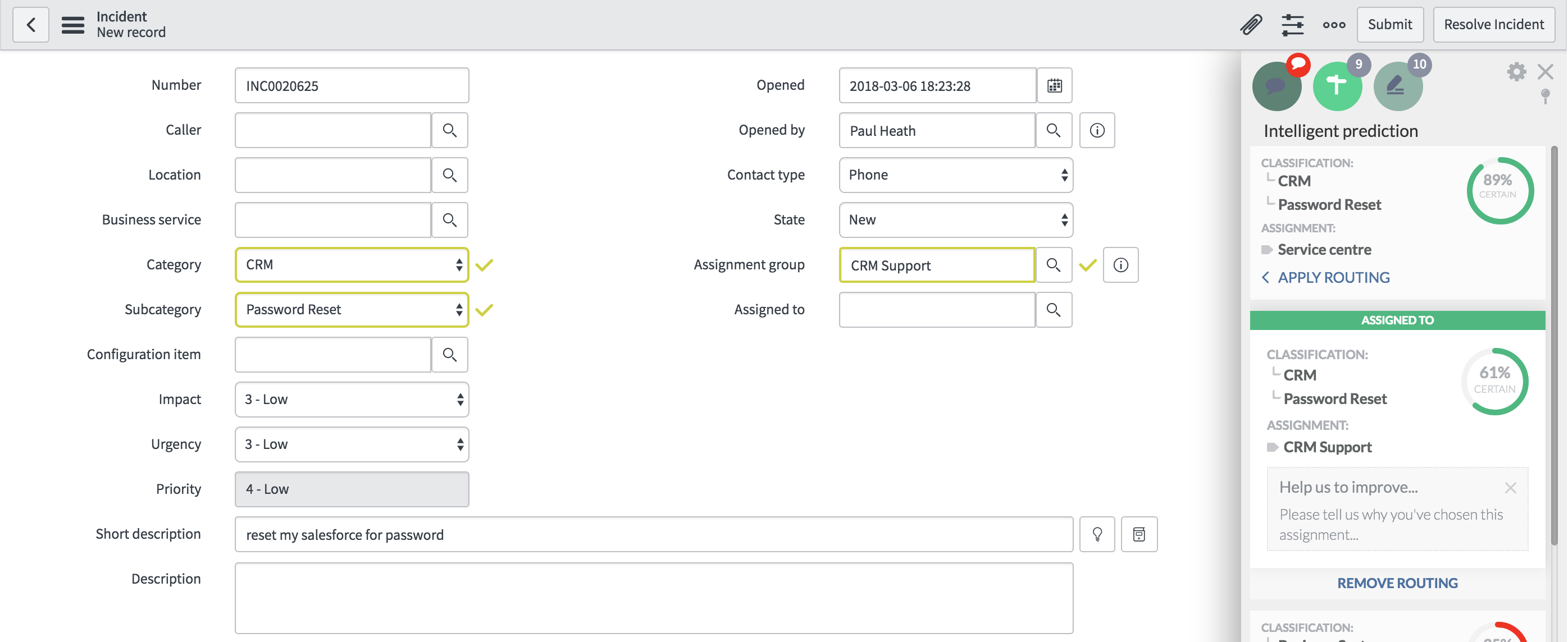Intelligent Prediction
Intelligent Prediction generates predictive models based on historical records stored within ServiceNow. Sofi accelerates call logging, triage, and issue resolution by providing service agents with contextual suggestions and automated actions based on what Sofi has learnt from previous interactions.
Sofi predicts (and can automatically set) field values based on the real-time (keystroke) analysis of a descriptive text field, typically the Short Description field. Sofi can also take into account other contextual information that may influence predictions such as the location of a caller when determining to which group to assign a call.
Sofi can apply this same predictive capability to ServiceNow records generated 'out-of-band' via email and system integrations. In this way, Sofi can deflect calls from the Service Desk either by responding to the customer automatically or by routing the call to the appropriate resolution team.
Predictive Models
Predictive models called Classifiers are configured, trained and then triggered to provide predictions within defined contexts - eg an Incident form.
Classifiers are defined against a table (or ServiceNow application). Multiple classifiers can be configured against each table. For example, you may have a Classifier on the Incident table that predicts Category, Subcategory and Assignment group based on the initial creation of the Incident. You may also have a classifier on the Incident table that predicts Closure code based on the entry of a solution.
Each Classifier consists of the following information:
- The input of Search field used to identify the predicted results eg Short Description
- The Classification fields that you want the classifier to predict (based on the input) eg Category and Assignment Group
- The training records used to train the Classifier - normally it's the entire contents of the source table however you can restrict the training records.
- Any filtering that you may need to apply based on business policies such as location based assignment
- The behaviour of Classifiers can be configured based on specific contexts. For example you may want a Classifier to automatically populate a field at a different threshold an incident that gets generated via the ServiceNow UI vs one that gets created via an Inbound Email action.
- A Trigger (ServiceNow Client Script) is defined to determine when a Classifier is fired.
Out of the Box Classifiers
By default, Sofi ships with a Prediction Classifier for the Incident table that predicts Category, Subcategory, Assignment Group based on Short Description. This Classifier also contains a Search Classifier for the standard ServiceNow Knowledge database.
Model Training and Continuous Learning
The critical success factor for most machine learning-based predictive algorithms is data. The accuracy of models are directly related to the quality of the training data used to train the model. Most predictive models require re-training to adjust and improve a model that has proven to be unreliable.
Sofi however, takes a different approach. Sofi assumes that the training data may have inconsistencies and has a unique capability to continuously learn based on feedback from service agents and as new data is created in the source table.

In the example above, the service agent has selected a prediction that is not the highest ranked prediction. A number of things have happened as a result:
- The predictive fields have a different style to indicate that this is not Sofi's highest ranked result;
- Sofi will dynamically update the Classifier model to take this feedback into account
- The agent is presented with an option to provide further information that may inform administrators as to why this was the preferred selection.
Triggers
A Trigger (ServiceNow Client Script) is defined to determine when a Classifier is fired. By default
Frequently Asked Questions
| Question | Answer |
|---|---|
| Is there minimum number of records that are required to train a Prediction Classifier? | No, however the more data you the more likely you will be to get robust results. |
| Are there any restrictions that exist before Sofi will begin to make predictions for a given input. | Yes, Sofi must have at least three 'valid' training records to train on before Sofi will make a prediction on an input (or utterance). The utterances don't need to be exactly the same but they need to have sufficient similarity to enable the Natural Language Processing engine to determine similarity. A 'valid' training record is one where all of the Classification fields (the fields the classifier is looking to predict) are set. |
| If my data changes (eg classification structure changes or my assignment groups change), how does Sofi manage invalid prediction values. | Sofi automatically removes from any prediction results any predicted values that are no longer valid. |
Updated almost 6 years ago
